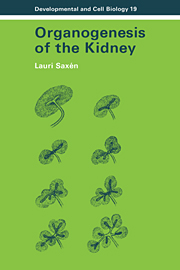Book contents
2 - Experimental methods to study kidney development
Published online by Cambridge University Press: 22 October 2009
Summary
Introduction
Most of our knowledge on the morphogenesis of the vertebrate kidney, reviewed in the previous chapter, has been gained from lengthy, descriptive studies on fixed material, with the exception of some experimental studies mentioned on p. 20. When classic, descriptive embryology shifted to developmental biology, focusing attention on the dynamics of development and on the control mechanisms of embryogenesis, an experimental approach became necessary. Analysis of development could now be implemented by experimental interference with various developmental events either in vivo or in various grafting systems. In vivo, the operations included destruction of specific tissues and organ anlagen or their transplantation into heterotopic sites isolated from neighbouring tissues. A complete separation from organismal influences could be achieved either by grafting the tissues into various hosts or by cultivating them in vitro under strictly controlled conditions. Since understanding of many present ideas of nephrogenesis – as well as appreciation of the lack of them – requires some knowledge of the basic techniques, they will be reviewed briefly in this chapter. The present grafting and culture techniques are emphasized, especially those devised primarily for studies of kidney development. More details of such experiments will be presented later, when their results and conclusions are discussed.
Early experiments in vivo
At the beginning of this century, embryologists who were exploring the embryogenesis of lower vertebrates developed many of the basic microsurgical techniques that are still in use. Experiments with amphibian embryos that were easily available and could be manipulated included transplantation of tissues, destruction of certain anlagen, and cell labelling.
- Type
- Chapter
- Information
- Organogenesis of the Kidney , pp. 35 - 50Publisher: Cambridge University PressPrint publication year: 1987



